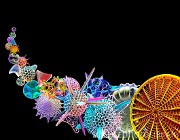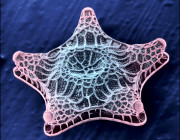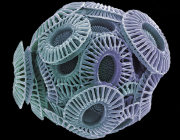Home :: List of Publicly Available Datasets :: Akashiwo sanguinea CCCM 885
Akashiwo sanguinea CCCM 885
Downloads:
| Principle Investigator(s) | Juan Saldarriaga |
|---|---|
| External sample ID | Aksang |
| NCGR Sample ID | MMETSP0223_2 |
| Sample accession number | CAM_SMPL_002482 |
| Assembly accession number | CAM_ASM_000300 |
| Combined Assembly Name | N/A |
| Genus | Akashiwo |
| Species | sanguinea |
| Strain | CCCM 885 |
| Clonal | Unknown |
| Axenic | No |
| Prelim. NCBI Taxon ID | 143672 |
| 18S rRNA | |
| Importance of organism and transcriptomes | Akashiwo sanguinea is a common bloom-forming dinoflagellate that has been implicated in fish kills. It is at best a nuisance organism, but in 2009 it was shown to produce proteinaceous surfactants that caused sea bird feathers to saturate with water; many birds died subsequently of hypothermia (Jessup et al. 2009). Morphologically it is very much gymnodinialean, but phylogenetic trees based on rRNA genes have not been able to place the genus with any degree of certainty. Nevertheless it does not seem to be a member of the Gymnodinium clade. |
| Additional citations and references | Jessup, David A.; Miller, Melissa A.; Ryan, John P.; Nevins, Hannah M.; Kerkering, Heather A.; Mekebri, Abdou; Crane, David B.; Johnson, Tyler A.; Kudela, Raphael M. (2009): Mass-stranding of marine birds caused by a surfactant-producing red tide. PLoS One 4: e4550 |
| Environmental Data | |
| Primary citation for organism's characterization, if available | Daugbjerg, N., Hansen, G., Larsen, J. & Moestrup, ?. (2000). Phylogeny of some of the major genera of dinoflagellates based on ultrastructure and partial LSU rDNA sequence data, including the erection of three new genera of unarmoured dinoflagellates. Phycologia 39: 302-317. |
| Latitude | 40.6666 |
| Longitude | -73.25 |
| Collection date | 20-JUL-58 |
| Sample collection site | Great South Bay, Long Island, New York |
| Sample material (e.g. "seawater," "sediment," etc.) | seawater |
| Habitat | marine habitat |
| Country | UNITED STATES |
| Experimental Data | |
| Date of experiment | 02-JUN-11 |
| Growth medium | HESNW |
| Modifications to growth medium | no silica |
| Temperature (ºC) | 18 |
| Salinty (psu) | 30 |
| pH | 7 |
| Light (µmol photons / m2 / sec) | 3800 |
| Day portion of day:night cycle in hours | 14 |
| Night portion of day:night cycle in hours | 10 |
| Nitrate (μmol/L) | 3 |
| Ammonium (μmol/L) | .11 |
| Phosphate (μmol/L) | .3 |
| Investigation type | Eukaryotes |








